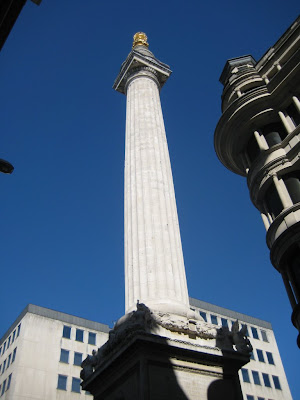The Monument
 On the way home from St Albans, I was on the City branch of the Northern Line, heading for London Bridge, intending to change there for the Jubilee Line to North Greenwhich. At Bank Station, after a couple of minor delays for "signals", the "gentle-but-authoritative-lady-voice" boomed out that London Bridge had been closed due to a "passenger incident". That left us with one of those "experienced Londoner" dilemmas -
On the way home from St Albans, I was on the City branch of the Northern Line, heading for London Bridge, intending to change there for the Jubilee Line to North Greenwhich. At Bank Station, after a couple of minor delays for "signals", the "gentle-but-authoritative-lady-voice" boomed out that London Bridge had been closed due to a "passenger incident". That left us with one of those "experienced Londoner" dilemmas -- District and Circle back to Westminster and go from there
- Docklands Light Railway to Canary Wharf and hop on the Jubilee farther down
- Black cab to Bermondsey to bypass London Bridge
- ...
In fact, by the time I had randomly meandered through the labyrinth which is Bank/Monument Stations, found myself near the District and Circle line platforms and hence not too far from fresh air, it was announced that London Bridge station was open again. Being so near the monument end of this complex, I decided to surface and have a look at Sir Christopher Wren's abiding testimony to the Great Fire of London (known simply as "The Monument".)
In 1681, even as the Titus Oates plot was beginning to flag, the inscription on the North side of the Monument blamed the Great Fire on "Popish Frenzy" but this allegation was eventually (in 1830) excised from the text.
Here is the English explanation on the West side (click to enlarge):
 and here is the Church of St Magnus the Martyr, built by Sir Christopher Wren as part of the post-incendiary reconstruction:
and here is the Church of St Magnus the Martyr, built by Sir Christopher Wren as part of the post-incendiary reconstruction:

